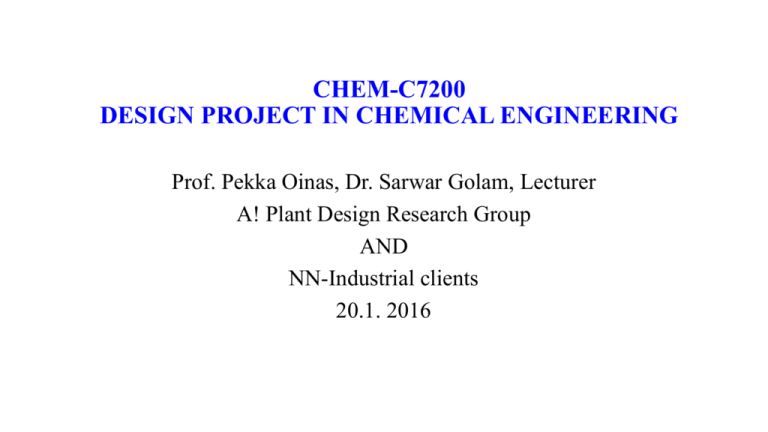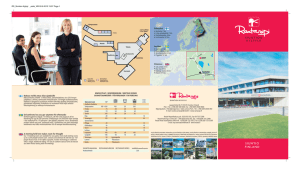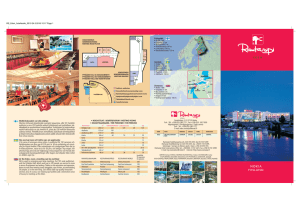CHEM-C7120 Laboratory project in chemical
advertisement

CHEM-C7200 DESIGN PROJECT IN CHEMICAL ENGINEERING Prof. Pekka Oinas, Dr. Sarwar Golam, Lecturer A! Plant Design Research Group AND NN-Industrial clients 20.1. 2016 DESIGN PROJECT IN CHEMICAL ENGG. Introduction to course Work contents Work method Practical arrangements Total 10 cr (270 h/each student) all work phases AIMS OF THE COURSE • Making a feasibility study • Process pre-design (with innovation) • Project work LEARNINGS • • • • Information searching Design methods Presentation of results Working procedure GRADING OF THE COURSE Grades: 1-5 Subjects to: 1. All reports (I-V) 2. Meetings 3. Seminar presentation 4. Learning log Justification basis: 1. Contents of reports 2. Working approach 3. Presentation skills 4. Innovation in design COURSE CONTENTS 1. MARKETS AND PROSESS ALTERNATIVES Application Costs /economic potential Quality Raw materials Properties Process alternatives, comparison and selection 2. PROCESS DESIGN OF THE SELECTED PROCESS Material balance Energy balance PFD Preliminary equipment sizing 3. DETAILED ENGINEERING Equipment sizing Selection of equipment P&I diagram of a particular process section Safety assessment Emissions & wastes Risks & permits • Heat integration 4. ECONOMICS Capital investment Operating costs Sales revenue Profitability Sensitivity analysis Financing Implementation timetable 5. SUMMARY Summery of the factors which affacts the feasibility of your project. COURSE STRUCTURE 1. The work is progress with agreed content (topic) and time schedule 2. Meetings: - Weekly - Report submission by due dates - Project meetings (after submission of reports) - Correction of report 3. Presentation in the seminar APPROACH Pre-feasibility study (= documents for investment decission) REPORTING Technical Report -> rather compact • In general: (source.inform.) -> (equation) -> (results) • Demanding tasks: (steps), (justification), (attachment) • Corrections with next report • Submission in due dates • Return to: Professor, Lecturer, instructors and industy clients WORK METHOD/HOW YOU SHOULD WORK? Group decides the work distribution of the project • each one (group member) has own part • group meet several times to exchange findings Project manager: • in charge of work • chair in the meetings Project Secretary: writes minutes of meeting (MOM) Project meeting: • Project manager expalins shortly main findings of the report and lead the speach • Secretary writes the Minutes of meeting (MOM) Duration (time) 1 – 1.5 h Project Meeting Agenda • Presences • Previous MOM, if any • Time schedule and hour estimation • Corrections of previous report • Presenting the new report (main results with justification) • Comments and discussions • Instruction to the next report • Selecting new project manager and secretary • Date and time for the next meeting I REPORT 1. PROJECT STARTUP • The technical goals • Hour estimation • Time schedule 2. MARKET REVIEW 1. 2. 3. 4. 5. 6. uses production export, import prices grades life cycle For both the products & the raw materials Market review is needed: - Choosing the capacity - Economic potential - Choosing location Producers & capacity : Finland, europe and world Import & export : location (areas) & prices Uses & grades general physical & chemical properties competitive products demand forecasts users in location markets future trends SOURCES OF INFORMATION PRICES & PRODUCERS Finnish customs statictics Industrial statistics Price table ICIS journal (and its journal databases) Importers catalog www (Avoid laboratory chemical manufacturer catalogs) ECONOMIC POTENTIAL Operating Margin = product price – raw material price (note. yield) CAPACITY based on market study (kg/h) operation time (h/a) 1/2/3-Shifts (discontinuous/continuous) LOCATION factors affecting comparison table + reasons (justifications) district levels PROCESS ALTERNATIVES Literature study: - handbooks - reference works - journal - process review - patents Specifically the modern processes and lists of sources PRINCIPLE OF LITERATURE RESEARCH • Start with: Handbooks (Ullmann’s,… Kirk-Othmer,…Mcketta…) Books; patents, www-pages Referenceworks (Scifinder, Compendex, Scopus..knovel...) Journals, Experts PROCESS PRINCIPLE 1. Draw block/principle diagram for few alternatives 2. Process description DRAWING PROGRAMS: MS Visio (recommended) Smartsketch AutoCad COMPARISON OF ALTERNATIVES 1. 2. 3. 4. Main differences Comparoson table with criteria and reasons Proposal + Justification Choose the bests alternative (Selection is confirmed in the 1st comment meeting) FIRST ( AT THE BEGINING) • Select project manager and secretary • time schedule • hour estimation - DESIGN PROJECT ( 10 cr = 1350 h/(5 st. in a group) - Reports: 1, 2, 3, 4, 5 15, 35, 25, 20, 5-% in hours Work hours of each students are presented in the hour estimation table SIMULATION PROGRAMS 1. Aspen Plus (in computer class) 2. PRO/II (in computer class) 3. SuperPro Designer (in computer class) 4. HSC Sim 5. Flowbat INDUSTRIAL TOPICS FOR SPRING 2016 1. Feasibility study of bio-oil refining. Pöyry/Tuukka Sormunen Kajaste Leinonen Nasiri Tajuddin 2. Recovery of organic acids and solvent precursors from forest industry biorefinery streams. Eastman/Jukka Hietala Häkkinen Montonen Rostami Veijalainen 3. Regenerated fibrecellulose carbamate CCA process. VTT/Ali Harlin Hassinen Henttonen Kabugo Perttula ATTACHMENT 1. Hour estimate and follow-up form DESIGN PROJECT HOUR ESTIMATION Työvaihe Estimate Realized Tot. Pekka Sarwar Lotta Maija Päivi TOTAL Design the project 20 8 5 5 6 7 31 Market study 45 8 25 0 0 34 67 Process alternatives 45 4 0 30 20 0 54 Principle diagram 10 10 0 0 4 0 14 Comparison of Pros. alternative 20 12 0 7 0 0 19 I- raport correction 10 20 0 2 0 0 22 I- raport Total 150 62 30 44 30 41 207 24,5 Design and compilation - 0 0 12 10,5 2 Selection of process 10 5 1 1 1 2,5 10,5 PFD 150 35 0 41,5 0 45 121,5 Balance calculation 90 7 40 44 51,5 24,5 167 Sizing 90 3 25,5 10,5 10 0 49 II- raport correction 30 23 3 21,5 15 0 62,5 II- raport Total 370 73 69,5 130,5 88 74 435 - 2,5 5 14 18 8 47,5 PI-diagram 50 0 0 0 0 38,5 38,5 Equipment sizing 60 0 4 40,5 14 4 62,5 Laitemääritt, luettelot 30 0 0 6,5 15 10 31,5 Lay-out 30 15 0 1 0 0 16 Energy inegration 10 1 0 0 10 0 11 Excursion 10 1,5 1,5 1,5 1,5 0 6 III raport correction 10 5 0 4,5 2 6,5 18 III raport Total 200 25 10,5 68 60,5 67 231 - 0 9 8,5 9 23 49,5 Invest. Kustannusarvio 50 0 10 25 20 22 77 Tarvittavat luvat 10 0 27 0 0 0 27 Päästöt 20 0 6 0 0 0 6 KäyttöKustannusarvio 50 16 5 5 1 20 47 Tuloslaskelma 30 10 0 0 0 0 10 Kannattavuus 30 14 0 0 10,5 0 24,5 Herkkyysanalyysi 20 0 11 0 0 0 11 Toteutuksen aikasuunn. 10 0 0 7 0 0 7 IV raportin korjaus 10 22 20 5 0 4 51 IV raportti yht. 230 62 88 50,5 40,5 69 310 Design and compilation Suunnittelu ja kokoaminen Loppuraportti TOTAL PROJECT HOURS. 50 16 25 14 22,5 30 107,5 1350 238 223 307 241,5 281 1390,5 ATTACHMENT 2 BAR CHART TASKS Design the project Markets Process alternatives Principle diagram Comparison of alternatives I raport correction I raport Total Prosessin valinta Virtauskaavio Taselaskenta Mitoitukset II raporin korjaus II raportti yhteensä PI-kaavio Laitemitoitukset Laitemäärittelyt, luettelot Käyttöohje Ei tehty Sijoitussuunnittelu Tarvittavat luvat Päästöt Energian säästö kesken Ekskursio III raportin korjaus III raportti yhteensä Investointikustannusarvio Käyttökustannusarvio Tuloslaskelma Kannattavuus Herkkyysanalyysi Toteutuksen aikasuunnitelma ei tehty IV raportin korjaus IV raportti yhteensä Loppuraportti raporttien kokousajankohdat YK1 3 P1 3 4 JAN 4 5 P2 5 6 6 7 FEB 7 P3 8 8 9 9 10 10 P4 11 MAR 11 12 12 13 13 P5 14 14 15 YK2 15 APR 16 16 VKO NOTE: DESIGN PROJECT requires knowledge on various topics; e.g. • equipment design • reaction technology • process chemistry, • mass and energy balances • process simulation • heat integration • process control, process safety • costs and profitability estimation, etc. These topics are not taught in this course but are considered as the background knowledge of participating students. Therefore, the design project course is recommended for senior students (before you start the M.Sc. Thesis).

